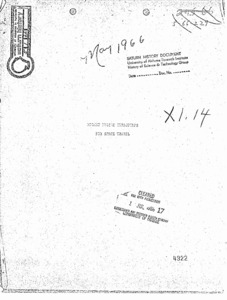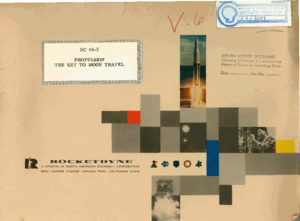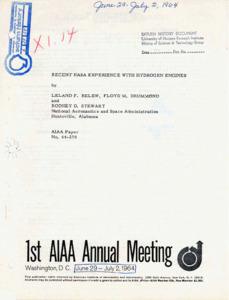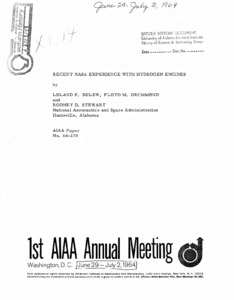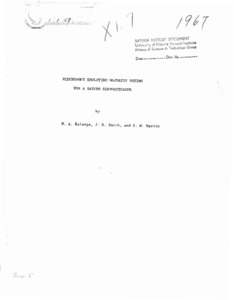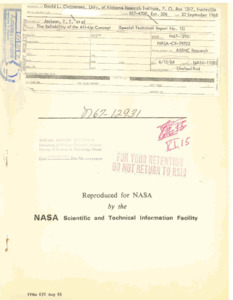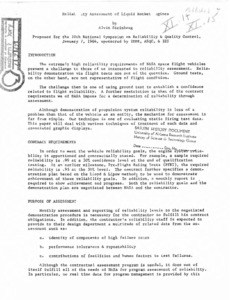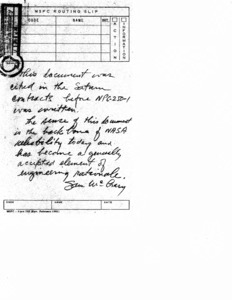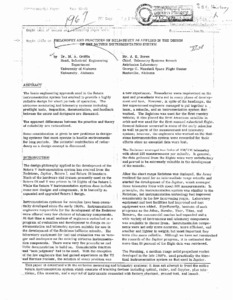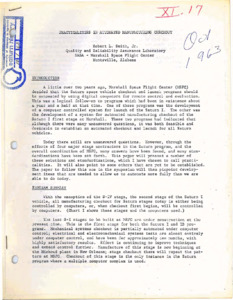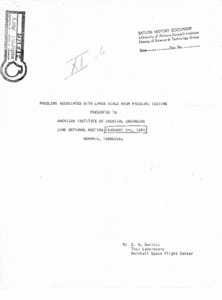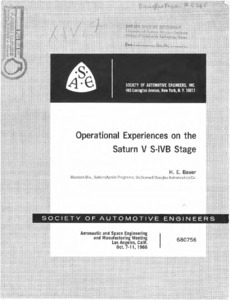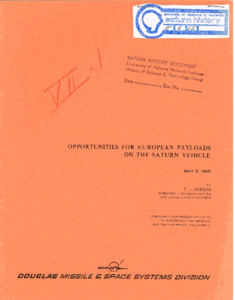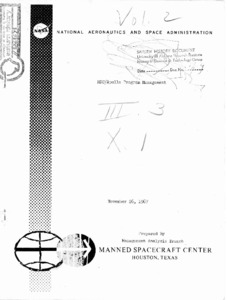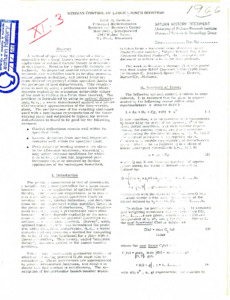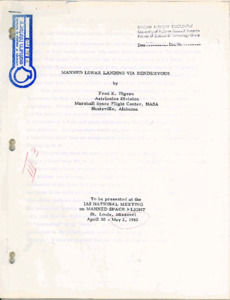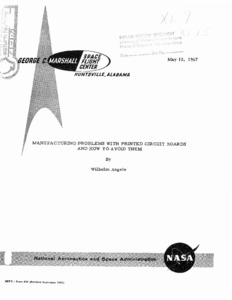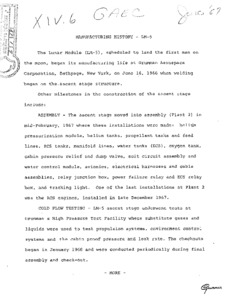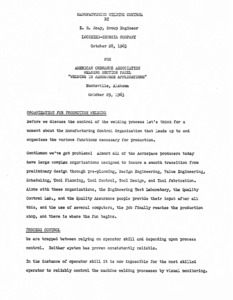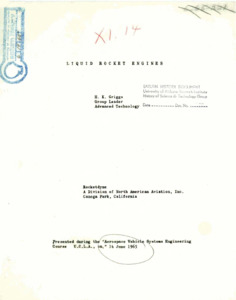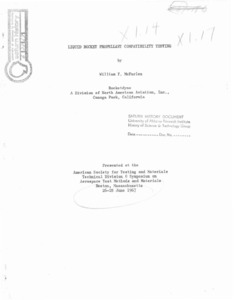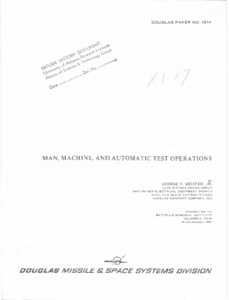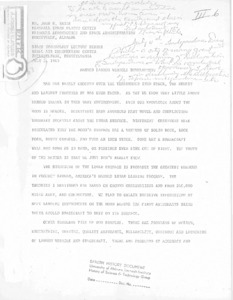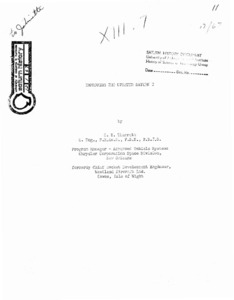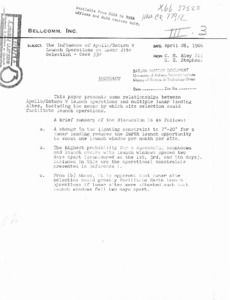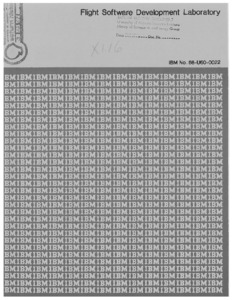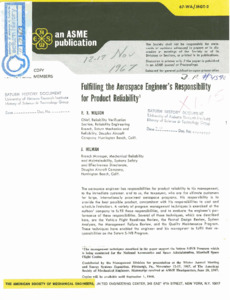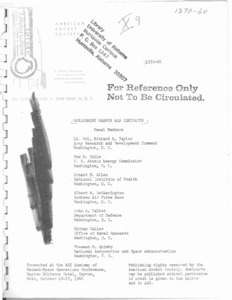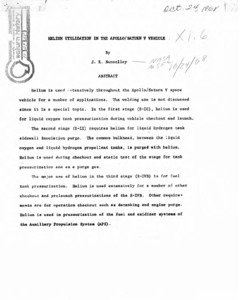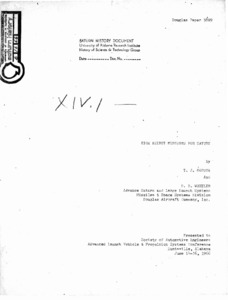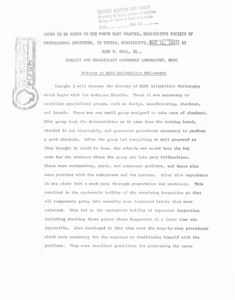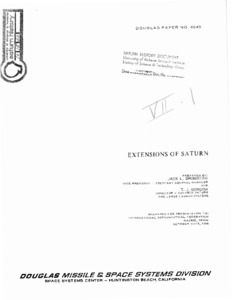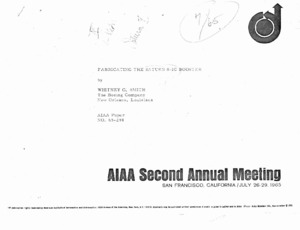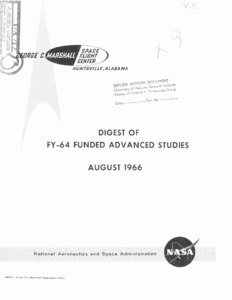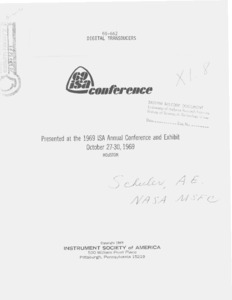
Browse Items (165 total)
Sort by:
-
"Rocket engine turbo pumps for space travel."
Finding the turbopump arrangement which is best suited for a given rocket engine - space travel applications - constitutes an important task. The arrangement depends upon a large variety of different factors, such as, the engine cycle, weight, the liquids to be pumped, the cavitation performance, the bearings and their lubrication, the seals and the turbine. In this report these factors and their influence on the turbopump configuration are discussed. It is shown that three of them: weight, propellants to be pumped and obtainable suction performance have the largest influence on the selection of the turbopump. A systematic approach is outlines for the design process, which allows to arrive at a turbopump arrangement best suited for a given application. -
"Propulsion : the key to space travel."
Cover has: P. D. Castenholz and H. K. Griggs, Advanced Systems, Advanced Projects Department. D. W. Hege, Manager, Advanced Projects. Paper regarding the importance of propulsion technology and the future missions that would require advancements in that field. -
"Propulsion : the key to moon travel."
Paper focusing on past and future moon missions. Contains graphics of rockets and modules -
"Recent NASA experience with hydrogen engines."
This paper presents a review of the experience which has accumulated in the development of the Liquid Hydrogen J-2 and RL10 rocket engines. These engines are being developed by the Rocketdyne Division of North American Aviation and Pratt & Whitney Aircraft, a Division of United Aircraft Corporation respectively.; On NASA Technical Reports Server (NTRS) as Unclassified; No Copyright; Unlimited; Publicly available. Also found on AIAA site. -
"Recent NASA experience with hydrogen engines."
This paper presents a review of the experience which has accumulated in the development of the Liquid Hydrogen J-2 and RL10 rocket engines. These engines are being developed by the Rocketdyne Division of North American Aviation and Pratt & Whitney Aircraft, a Division of United Aircraft Corporation respectively.; On NASA Technical Reports Server (NTRS) as Unclassified; No Copyright; Unlimited; Publicly available. Also found on AIAA site. -
"Redundancy employing majority voting for a Saturn servoactuator."
R-ASTR-NF.; ABSTRACT: The servoactuator was developed to improve the reliability of the Saturn S-IVB thrust vector control system by insuring continued system operation if single point failures occur. The selection of the majority voting technique is discussed. Its simplicity is cited along with the advantages of minimum weight, size, power consumption, and compatibility with existing control electronics. Operational features, design mechanization, and the analysis of test results are covered. -
"The reliability of the all-up concept."
Prepared for George C. Marshall Space Flight Center, Huntsville, Alabama under contract NAS8-11087. Publication No. 294-02-12-440. Special Technical Report No. 13.; INTRODUCTION: The Saturn/Apollo Systems Office at the George C. Marshall Space Flight Center (MSFC) requested ARINC Research Corporation to make a brief study of the reliability aspects of the All-Up concept. Under the requirements of Task 294-02 of Contract NAS8-11087, the study included a comparison between the reliability of the first Saturn V vehicle if All-Up, and its reliability with dummy upper stages. -
"Reliability assessment of liquid rocket engines."
Proposed for the 10th National Symposium on Reliability & Quality Control. This paper will deal with various techniques of treatment of such data and associated graphic displays. -
"Reliability engineering program provisions for Space System contractors. Revision 2."
This document was cited in the Saturn contracts before NPC-250-1 was written. The sense of this document is the backbone of NASA reliability today and has become a generally accepted element of engineering rationale. -
"Philosophy and practices of reliability as applied in the design of the Saturn Instrumentation System."
The basic engineering approach used in the Saturn instrumentation system has evolved to provide a highly reliable design for short periods of operation. The airborne measuring and telemetry systems including preflight tests, inspection, documentation, and feedback between the users and designers are discussed. The apparent differences between the practice and theory of reliability are rationalized. Some consideration is given to new problems in designing systems that must operate in hostile environments for long periods. The potential contribution of redundancy as a design concept is discussed.; This paper is concerned with the airborne measuring and telemetry systems; it does not attempt to treat the entire Saturn instrumentation system which consists of tracking devices including optical, radar, and Doppler, plus television, film cameras, and a myriad of instruments connected with factory checkout, ground test, and launch. -
"Practicalities in automated manufacturing checkout."
This paper presents a number of solutions to a number of unanswered questions regarding the Saturn projects. -
"Problems associated with large scale high pressure testing."
Paper detailing the problems identfified in high pressure testing. -
"Operational Experiences on the Saturn V S-IVB stage."
This paper presents a light, but reverent, discussion of some of the Douglas operational experiences on the Saturn V/S-IVB stage. Certain relevant aspects of earlier work on the Thor intermediate range ballistic missile, the Saturn I S-IV stage, and the Uprated Saturn I S-IVB stage are also discussed.; Aeronautic and Space Engineering and Manufacturing Meeting, Los Angeles, Calif., Oct. 7 - 11, 1968. -
"Opportunities for European Payloads on the Saturn Vehicle."
Prepared for presentation to the Eurospace Conference. In this paper, we will not deal with the first two questions, which must be of interest to every potential experimenter, but only with the last question of vehicle availability. -
"Organization of a countdown"
The Organization of a Countdown was developed over 8 years of missiles and space systems testing at the Douglas Aircraft Company, Sacramento test Center. The experience on which this study was based includes the Thor development and acceptance testing, Titan I second stage engine development testing, Development of liquid hydrogen handling techniques, Saturn S-IV and S-IVB development and acceptance testing. The intent of this paper is to examine the static test countdown organization and discuss the need for a systematic method to organize a countdown. -
"MSC/Apollo program management"
The purpose of this document is to describe how the Manned Spacecraft Center is managing its responsibilities in the Apollo Program The organization, procedures, and management philosophy described herein, represent the accumulated knowledge gained from our experience with the Mercury, Gemini, and Apollo Programs. It should be remembered, however, that managing a research and development program of Apollo's size and complexity, is an experimental "R&D" process in itself. -
"Minimax control of large launch boosters."
Keith D. Graham is principal mathematician, Systems and Research Center, Honeywell, Inc., 2345 Walnut Street, St. Paul, Minnesota.; Work done under NASA contract NAS 8-11206 from the George C. Marshall Space Flight Center.; ABSTRACT: A method of specifying the gains of a linear controller for a large launch booster using a new application of optimal control theory is described in this paper. Results for a specific example are included. An important control requirement is to maintain cost variables (such as bending moment, engine gimbal deflection, and lateral deviation from desired trajectory) within specified limits in the presence of load disturbances. This requirement is met by using a performance index which depends explicitly on maximum achievable values of the cost variables in a finite time interval. -
"Manned Lunar Landing via Rendezvous."
Paper to be presented at the IAS National Meeting on Manned Space Flight. Focuses on operations leading to injection of the space craft into the lunar transfer trajectory. -
"Management problems faced in making future manned space exploration decisions."
This paper presents in synoptic form, an analysis of the management problems being faced in making fuhlre manned spaceflight decisions. It is an attempt to view the manned space program in total perspective - its relationship to other scientific research, other national programs, the role of Congress, the President's role, industry's role, and then show their relative influence and impact on decisior, making for the Post-Apollo period. -
"Manufacturing problems with printed circuit boards and how to avoid them."
To be presented at the NASA / Rocketdyne Manufacturing Technology Review. Focuses on how best to avoid printed circuit boards. -
"Manufacturing history - LM-5."
Essay that focuses on the achievements of the Grumman Aerospace Corporation. -
"Manufacturing welding control by E. R. Seay, Group Engineer, Lockheed-Georgia Company."
Paper given at the American Ordnance Association Welding Section Panel. Focuses on the process of welding and development programs. -
"Liquid Rocket Engines."
This paper presents a discussion on liquid propellant rocket engines. The first part contains a discussion on liquid propellants, including a description of various propellant types such as cryogenic, storable,bipropellant, and monopropellant. This part also points out desirable physical properties and includes a section on performance outlining the methods by which performance is calculated and shows performance for various liquid rocket propellant combinations. -
"Liquid Rocket Propellant Compatibility Testing."
Material-propellant compatibility as related to liquid rocket propulsion system design criteria is discussed and applicable test methods to derive usable design data are presented. Test methods, with emphasis on metallic materials, are discussed and the shortcomings of a number of these test methods are pointed out. These tests include static immersion tests, stress-corrosion tests, flow tests, impact tests, and tests to determine the effect of cracks and notches in metals on compatibility. A general outline for the evaluation of metallic and nonmetallic materials with respect to propellant compatibility is presented. -
"Man, Machine, and Automatic Test Operations."
Essay detailing the relationship between men and machines." -
"Manned Launch Vehicle Development."
Includes handwritten notes. Includes references to slides. Essay remarking on how space vehicles will interact on the moon's surface. -
"Improving the Uprated Saturn I."
This paper discusses five improved versions of the Uprated Saturn I that were studied by the Chrysler Corporation Space Division, supported by the Douglas Aircraft Corporation. -
"The Influence of Apollo/Saturn V Launch Operations on Lunar Site Selection: Case 330."
This paper presents some relationships between Apollo/Saturn V launch operations and multiple lunar landing sites, including the means by which site selection could facilitate launch operations. -
"Instrumentation Programming for Computer Controlled Digital Data Processing."
A number of considerations are necessary in instrumentation programming, many of which are either not applicable or applicable to a lesser degree in other types of programming. This paper discusses these problems in general terms and illustrates how they have been dealt with specifically. The latter is done by describing the programming and operation of a data reduction system. -
"Flight Software Development Laboratory."
A man-in-the-loop computer facility has been created using a digital computer, display terminal,and space vehicle flight computer to enable programmers to check out flight programs in a simulated space flight environment. The simulation requires a real time multi-programmed environment, which is supplied by a control system capable of scheduling programs on 32 levels of priority interrupt as well as answering demands for service at the display terminal. A special interface device permits visibility and control of the flight program as it executes in the flight computer. On-line inputs from the programmer at the display terminal and outputs from data collection and reduction routines to the display screen are executed in real time. The Flight Software Development Laboratory has proved to be very useful in reducing program preparation time and increasing flight program confidence. -
"Fulfilling the Aerospace Engineer's Responsibility for Product Reliability."
The management techniques described in the paper support the Saturn S-IVB Program which is being conducted for the National Aeronautics and Space Administration, Marshall Space Flight Center. -
"Government Grants & Contracts."
The Army medical contract, grant, and research interest in the bio-science area. -
"Helium Utilization in the Apollo/Saturn V Vehicle."
Helium is used extensively throughout the Apollo/Saturn V space vehicle for a number of applications. The welding use is not discussed since it is a special topic. In the first stage (S-IC), helium is used for liquid oxygen tank pressurization during vehicle checkout and launch. -
"High Energy Missions for Saturn."
Presented to Society of Automotive Engineers, Advanced Launch Vehicle & Propulsion Systems. When the Apollo lunar landing project is complete, the Saturn and Apollo hardware will only have begun to realize their ultimate potential for space exploration. The immense reserve of Apollo technology, facilities, and booster capability can then be directed to the achievement of national goals which lie far beyond the initial lunar landing. In achieving the Apollo lunar objectives, large investments will have been made in launch facilities, tracking systems, propulsion techniques, reentry systems, lunar landing systems and rendezvous technologies. Although developnent in these specialized areas has been tailored to the needs of Apollo, numerous studies by NASA and industry have demonstrated the feasibility of using the spacecraft, launch vehicles, and operating techniques for missions far more complex than lunar landings. Amortization of this hardware will prove cost-effective for missions of more sophisticated applications. -
"History of MSFC Reliability Philosophy."
Paper given to North East Chapter , Mississippi Society of Professional Engineers. Essay discussing the history of the MSFC Reliability Philosophy. -
"Engineering Safety Into Missile-Space Systems."
Safety Engineering, as applied to complex missile and space systems, has developed a new methodology referred to as "System Safety Engineering." The requirement for a comprehensive approach to safety which is included as a contractually covered adjunct to the design, development, and operational phases of a systems life cycle has become apparent from costly missile mishap experience. The general concepts and accomplishments of this new engineering discipline are described along with possible beneficial relationships with Reliability and other recognized organizational elements engaged in safety related activities. -
"Extensions of Saturn."
This paper discusses the possible applications of Saturn vehicles to future space exploration. Potential missions utilizing Apollo derived hardware are examined. Research, development, and operations in earth orbit as well as lunar exploration, unmanned and manned interplanetary exploration are reviewed. These hypothetical missions are discussed in the context of the present and potential capability of three configurations of the Saturn vehicle; an uprated Saturn I, a three-stage Saturn V and a four-stage Saturn V. NOTE: Work presented herein was conducted by the Douglas Missiles and Space Systems Division under company-sponsored research and development funds. Therefore, the concepts and objectives described within this paper reflect the opinions of the authors and do not necessarily constitute endorsement by NASA, the Air Force, or any other U.S. Government organization. The nominal performance numbers presented are typical of the current configurations and possible future vehicle configurations. -
"Fabricating the Saturn S-IC Booster."
AIAA Second Annual Meeting, San Francisco, California. Discusses the fabrication process of the Saturn S-IC booster. -
"Digest of FY-64 Funded Advanced Studies: August 1966."
This paper outlines the major advantages of digital transducers and describes the principles and features (1) direct digital transducers, (2) indirect digital transducers, (3) quasi-digital transducers, and (4) A to D transducers. The mutual effect of transducers and systems will be discussed briefly, and some trends of transducer research and development will be presented. -
"Digital Transducers."
This paper outlines the major advantages of digital transducers and describes the principles and features (1) direct digital transducers, (2) indirect digital transducers, (3) quasi-digital transducers, and (4) A to D transducers.
